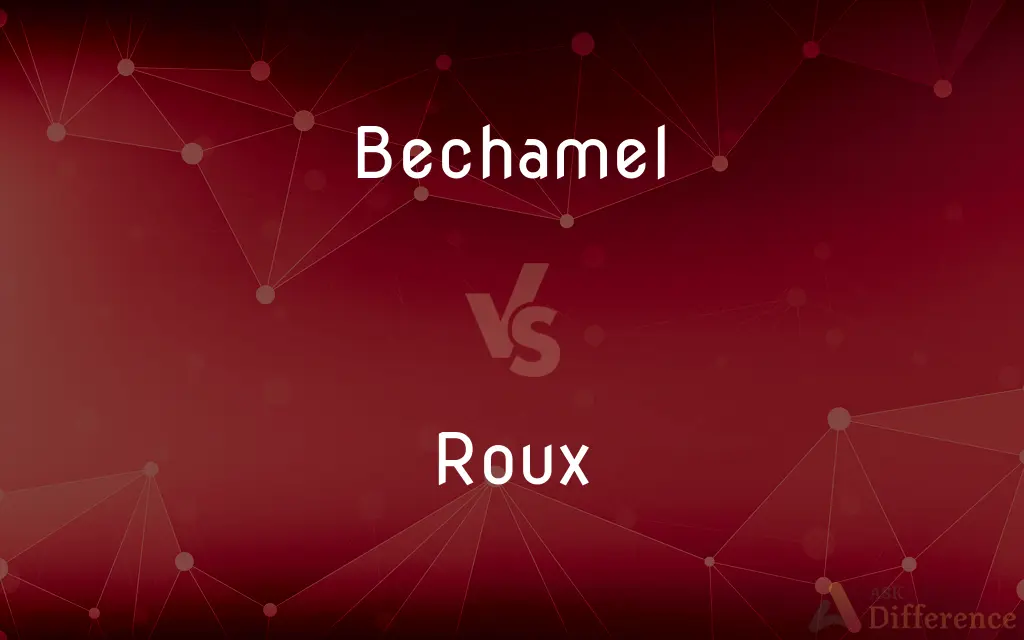Bechamel vs. Roux — What's the Difference?
By Tayyaba Rehman — Updated on September 26, 2023
Bechamel is a creamy white sauce made using milk, butter, and flour. Roux is a mixture of fat (usually butter) and flour used as a thickening agent. Roux serves as the base for Bechamel.

Difference Between Bechamel and Roux
Table of Contents
ADVERTISEMENT
Key Differences
Bechamel and Roux are integral elements in classic culinary preparations, especially in French cuisine. Understanding their distinctions is essential for mastering several dishes.
Bechamel is one of the five "mother sauces" in French culinary arts. It is a white sauce made primarily from milk that's been thickened with a white roux. The sauce's smooth, velvety texture, combined with its mild flavor, makes it a versatile ingredient in various dishes, from lasagna to creamy soups.
On the other hand, Roux is a simple mixture that predates Bechamel. Composed of equal parts fat (typically butter) and flour, Roux is cooked to varying degrees, depending on its intended use. The cooking process eliminates the raw taste of the flour, and when combined with a liquid, the Roux serves as a thickening agent.
In essence, while Bechamel is a sauce with diverse applications in cooking, Roux is a foundational element not just for Bechamel but also for other sauces and soups. The nuanced difference lies in their composition and purpose: Roux is a thickener, and Bechamel is a sauce that utilizes Roux as its base.
Comparison Chart
Composition
Milk, butter, and flour
Equal parts fat and flour
ADVERTISEMENT
Purpose
Used as a sauce in various dishes
Thickening agent for sauces/soups
Texture
Creamy and velvety
Paste-like consistency
Cooking Time
Longer, ensuring a smooth consistency
Varies (white, blonde, or brown)
Origin
French "mother sauce"
Foundational culinary element
Compare with Definitions
Bechamel
One of the French "mother sauces."
In culinary school, Bechamel is a fundamental sauce taught.
Roux
A mixture of equal parts fat and flour.
She started the sauce by making a Roux.
Bechamel
Can be enriched with cheese or herbs.
She added cheddar to the Bechamel for extra richness.
Roux
White, blonde, or brown.
For gumbo, a dark Roux is essential.
Bechamel
Smooth, creamy consistency ideal for various dishes.
The fish was baked in a Bechamel sauce.
Roux
Used as a thickening agent in culinary dishes.
The soup's consistency was achieved using a Roux.
Bechamel
A white sauce made using milk, butter, and flour.
Lasagna layers often contain Bechamel for creaminess.
Roux
Forms the base for several sauces, including Bechamel.
The Roux ensured the gravy was lump-free.
Bechamel
Often seasoned with nutmeg or onion.
A pinch of nutmeg enhances the Bechamel's flavor.
Roux
Roux () is flour and fat cooked together and used to thicken sauces. Roux is typically made from equal parts of flour and fat by weight.
Bechamel
Alternative spelling of béchamel
Roux
A mixture of flour and fat cooked together and used as a thickening.
Bechamel
A rich, white sauce, prepared with butter and cream.
Roux
A mixture of fat (usually butter) and flour used to thicken sauces and stews.
Bechamel
Milk thickened with a butter and flour roux
Roux
A thickening, made of flour, for soups and gravies.
Roux
A mixture of fat and flour heated and used as a basis for sauces
Roux
Eliminates the raw taste of flour when cooked.
Cooking the Roux well prevented a raw flour taste in the sauce.
Common Curiosities
What's the primary ingredient in Bechamel?
Milk is the primary ingredient in Bechamel.
How does the texture of Bechamel differ from Roux?
Bechamel is creamy and velvety, while Roux has a paste-like consistency.
How is Roux used in cooking?
Roux serves as a thickening agent for sauces and soups.
Can Bechamel be made without Roux?
Traditionally, Bechamel uses Roux as its base for thickness.
What fat is typically used in Roux?
Usually, butter is the preferred fat for Roux.
Share Your Discovery

Previous Comparison
Homonym vs. Pun
Next Comparison
Message vs. IdeaAuthor Spotlight
Written by
Tayyaba RehmanTayyaba Rehman is a distinguished writer, currently serving as a primary contributor to askdifference.com. As a researcher in semantics and etymology, Tayyaba's passion for the complexity of languages and their distinctions has found a perfect home on the platform. Tayyaba delves into the intricacies of language, distinguishing between commonly confused words and phrases, thereby providing clarity for readers worldwide.













































